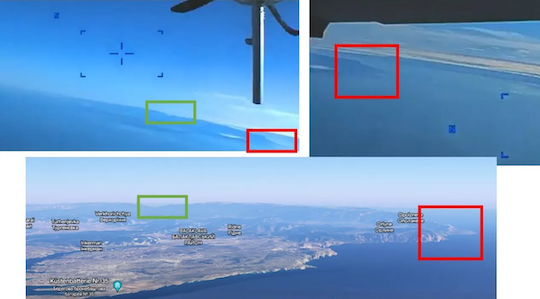Pentagon Lied About the Drone
Headlines this past week have been dominated by the new global banking crisis and rightly so.
We’ve seen the sequential collapses of Silvergate Bank, Silicon Valley Bank and Signature Bank, along with the bailouts of First Republic Bank and Credit Suisse.
You can be certain that more bank failures are on the way. And you can be sure I’ll be on top of it.
Still, the banking crisis is not the only newsworthy development and may not even be the most important…
The continual escalation of the war in Ukraine leading us on the path toward World War III and perhaps nuclear annihilation is clearly more important. Yet it gets nowhere as much attention.
You’ve heard about the recent incident in which two Russian fighter jets buzzed a U.S. drone (the MQ-9 Reaper) over the Black Sea near Russian Crimea.
Reports vary about what happened, but the most credible version is that the Russians disabled the drone by dumping fuel on it and touching the drone’s propeller (located in the rear of the drone) with one of the fighter jets. The propeller naturally got shredded and the drone fell into the sea.
If true, that’s excellent flying by the Russian pilots. From there, the story gets more complicated.
The Middle of the Black Sea? Really?
The Russians claim the drone was in or near Russian airspace. The U.S. does not recognize Crimea as Russian, so there would have been no airspace violation in the U.S. view.
The Pentagon released a flight tracker diagram that showed the drone in the middle of the Black Sea, minding its own business. This is most likely a Pentagon lie starting with the fact that there’s almost no reason to be in the middle of the Black Sea in the first place.
Even putting that aside, video from the drone itself clearly shows that it was operating very close to Crimea at the time of the incident, not in the middle of the Black Sea.
In these two pictures, you can clearly see land in the background. That doesn’t look like the middle of the Black Sea to me. The bottom picture shows the specific piece of land in question on the Crimean Peninsula.

Again, these two pictures were captured during the incident itself, so there’s your smoking gun. The drone was clearly operating right off Crimea, not in the middle of the Black Sea.
Incidentally, the drone was flying with its transponder turned off, which is a violation of international aviation guidelines. A transponder identifies the aircraft. Why was its transponder turned off? I’ll leave that to you to figure out.
U.S. Isn’t Exactly Neutral
Regardless of the details, there’s no dispute that Russian pilots forced the U.S. drone out of the sky. This is the first time that U.S. and Russian aircrafts have come in direct contact in a way that caused a lost aircraft, albeit no shots were fired by Russia and the drone was unmanned.
But should it come as a surprise?
The U.S. gathers intelligence from drones and other aircraft that it passes on to Ukraine, which is used to target Russian forces. That makes us a belligerent in the war, and a legitimate target for the Russians.
Sen. Lindsey Graham doesn’t tell you that. He wants you to believe that the U.S. was just minding its own business when those dastardly Russians took down our drone. He wants the U.S. to retaliate by shooting down Russian aircraft over international waters.
But the Pentagon has more or less downplayed the incident, which shows that cooler heads may prevail this time.
The Pentagon just wants the whole thing to go away because it doesn’t want to have to answer uncomfortable questions about it.
But who knows where another incident like this might lead?
Up the Escalation Ladder We Go
This is just the latest in a long line of escalatory conduct by both the U.S. (the 2014 coup, providing stingers, javelins, HIMARS, ammunition, Patriots and the promise of tanks and more on the way) and Russia (the 2022 invasion, increased troop levels, massive artillery bombardment and more).
Ukraine’s Zelenskyy has also demanded U.S. F-16 fighter jets and even deeper U.S. intervention.
Both sides can point fingers, but at some point, the belligerents lose sight of who started the escalation and just focus on the escalation itself.
Here’s a scenario to consider: Imagine that at some point, Russia begins to win the war decisively and Ukraine is on the verge of collapse.
That’s not unrealistic given the serious ammunition shortages Ukraine is now facing. They’re running especially low on artillery shells, and NATO just doesn’t have many more to give them. On the other hand, Russian factories are working around the clock, cranking shells out.
It’s a numbers game, and Russia has the numbers. Sooner or later, that will manifest itself on the battlefield.
So what would the Biden administration and its NATO allies do at that point? Do they simply call up Vladimir Putin and say, “OK, you won”?
Not likely. They’ve already invested so many resources and so much prestige in Ukraine, their reputation is on the line. To lose outright to Russia in this proxy war would be a bigger strategic disaster for the U.S. than Afghanistan, Iraq or any other geopolitical setback since Vietnam.
Desperation
If Russia is on the verge of victory, the allies may do something desperate like send troops into western Ukraine on some humanitarian pretext. The White House and its allies might justify it by claiming it’s to prevent Russian war crimes against civilians, or what have you. But it would set the stage for a direct clash with Russian forces.
Or Biden and his allies could strongly “encourage” Poland to send in troops to western Ukraine to take on the Russians. The Poles could be our next proxy. By the way, Poland’s leadership may be even more anti-Russian than ours, so that’s not impossible.
I’m not necessarily predicting any of this at this stage, but these are real possibilities we need to consider. They’re certainly more plausible than Ukraine winning the war, which isn’t realistic. It seems that even the highly pro-Ukraine media are beginning to come to that realization.
The only real question is how we handle it.
But war games, theory and history all point to escalation leading to nuclear war.
The U.S. conducted history’s only nuclear war from Aug. 6–9, 1945. We may be getting close to another one if we’re not careful. Very few seem even to notice.
Unfortunately, it might be too late once they do.



Comments: